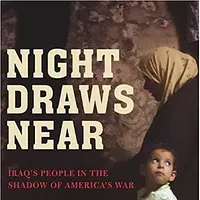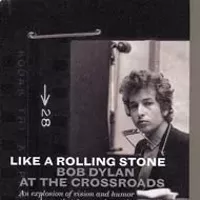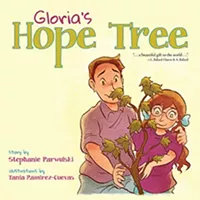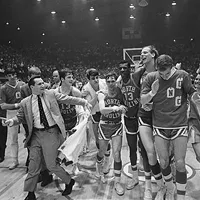Typically, this little vignette would have stimulated amused reflections on how this politically correct attempt to educate rather than exploit the worker paralleled McDonald's lame advertising campaign to make its food part of a weight-loss program. But I had been reading Luis Alberto Urrea's book, The Devil's Highway, on the trip, and instead of dwelling cynically on the corporation, I was filled with happiness for the young brown man in his new work garb seriously following his nerdy boss's spiel. He had made it. One way or another, he had found his way from Mexico to Laramie. He now had a real job making the American minimum wage and could start paying off the enormous debts he owed to the hustlers and gangsters who got him over the border. Eventually his family in Mexico might benefit from his wages as well. I was witnessing a contemporary success story, which I could not have appreciated without Urrea's help.
The Devil's Highway is a winding, changing path through the Sonoran Desert on the wild border between Arizona and Mexico. Hundreds, thousands, of Mexican workers borrow thousands of pesos from the human smuggling network to be guided through the wastes by guides, known as "coyotes." The workers, mostly illiterate, from incredibly poor villages in the mountains or the tropics, have no experience with the rigors of the desert. As Urrea makes abundantly clear, the Sonoran Desert is a killing landscape; temperatures regularly go above 110 degrees Fahrenheit in the daytime and often stay above 90 degrees at night. Anyone lost there between the border and the promised land of a rest stop on Interstate 8 near Yuma dies within a day or two from dehydration and is reduced to a leathery black mummy within four or five days.
The core of The Devil's Highway is the story of 26 men who made a failed attempt to cross the desert. In telling their story, Urrea creates a concise but thorough portrait of the culture of human smuggling that has permeated the Southwest.
On the official American side are the Border Patrol agents with their high and low tech detection arsenal and paramilitary bravado, playing a deadly game of tag with the desert walkers. On the official Mexican side, consular officials must process those found by the Border Patrol, both live and dead.
Urrea reveals the vagaries of the enforcement process, particularly in light of post-9/11 concerns; yet most affecting and potent are his carefully researched portraits of the 26 doomed Mexican walkers themselves. On a Saturday in May they entered the desert, by the next day it was clear that their coyote was lost and they were wandering desperately. By the following Wednesday, when they were found, 14 of the men were dead.
Urrea tells their story from the beginning, skillfully presenting the economic hardship and idealistic aspirations that humanize their quest, then using the accounts of the survivors to evoke their suffering on the desert in excruciating detail. Urrea describes a modern day massacre of the innocents -- decent but simple folk led into a literal hell by border policies that funnel illegals into the most horrific part of the desert at the mercy of loan sharks and organized crime.
Urrea has a number of common sense recommendations for improved border policies. He particularly laments how a seeming breakthrough easing Mexican access to the USA in early 2001 between President Bush and Mexican President Vincente Fox got lost in the rush to seal borders to terrorists after 9/11.
Ultimately, though, The Devil's Highway is not about abstract policies; it narrates the pathos and tragedy of Mexican immigration through the real experiences of those directly involved. To read it is to gain the empathy that I felt in Laramie for the terrible adventures endured by those who crave the work most Americans would rather avoid.
Latest in Books
More by Bruce G. Nims
-

Mop top scholarship
Nov 16, 2005 -

In Their Own Words
Oct 12, 2005 -

Dylanology 601
Apr 27, 2005 - More »
Calendar
-
 RuPaul's Drag Race Werq The World Tour 2025 @ Ovens Auditorium
RuPaul's Drag Race Werq The World Tour 2025 @ Ovens Auditorium -
 Boulet Brothers Dragula: Season 666 Tour @ N.C. Music Factory
Boulet Brothers Dragula: Season 666 Tour @ N.C. Music Factory -
 Jim Norton @ The Underground
Jim Norton @ The Underground -

Trap & Paint + Music Bingo @ Blush CLT
-

Trap & Paint (Hookah Edition) @ Blush CLT
-
Full Color
The ink is black, the page is white
-
Exploring Outer Banks: North Carolina
-
A Many-Splendored Plaid
Plus, Evelyn Glennie's fascinating rhythms










